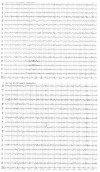A New De Novo Missense Variant of the TET3 Gene in a Patient with Epilepsy and Macrocephaly
- PMID: 39273623
- PMCID: PMC11395583
- DOI: 10.3390/ijms25179676
A New De Novo Missense Variant of the TET3 Gene in a Patient with Epilepsy and Macrocephaly
Abstract
The etiology of neurodevelopmental disorders and epilepsy is very heterogeneous and partly still unknown, and the research of causative genes related to these diseases is still in progress. In 2020, pathogenic variants of the TET3 gene were associated with Beck-Fahrner syndrome, which is characterized by neurodevelopmental delay, intellectual and learning disabilities of variable degree, growth abnormalities, hypotonia and seizures. Variants of TET3 have been described having both an autosomal dominant with a milder phenotype and an autosomal recessive pattern. To date, in the literature, only 28 patients are reported with pathogenic variants of the TET3 gene, and only 9 of them have epilepsy. We describe a 31-year-old woman with macrocephaly, mild neurodevelopmental delay and a long history of epilepsy. Trio-based exome sequencing identified a de novo heterozygous TET3 variant, c.2867G>A p.(Arg956Gln), never described before, absent in the general population and predicted to be potentially pathogenetic by bioinformatics tools. This report aims to describe the clinical history of our patient, the pharmacological treatment and clinical response, as well as the biological characteristics of this new variant.
Keywords: TET3; dysarthria; epilepsy; macrocephaly.
Conflict of interest statement
The authors declare no conflicts of interest.
Figures




References
-
- Beck D.B., Petracovici A., He C., Moore H.W., Louie R.J., Ansar M., Douzgou S., Sithambaram S., Cottrell T., Santos-Cortez R.L.P., et al. Delineation of a Human Mendelian Disorder of the DNA Demethylation Machinery: TET3 Deficiency. Am. Soc. Hum. Genet. 2020;106:234–245. doi: 10.1016/j.ajhg.2019.12.007. - DOI - PMC - PubMed
-
- Sager S.G., Turkyilmaz A., Gunbey H.P., Karatoprak E.Y., Aslan E.S., Akın Y. A novel de novo TET3 loss-of-function variant in a Turkish boy presenting with neurodevelopmental delay and electrical status epilepticus during slow-wave sleep. Brain Dev. 2023;45:140–145. doi: 10.1016/j.braindev.2022.09.004. - DOI - PubMed
-
- Seyama R., Tsuchida N., Okada Y., Sakata S., Hamada K., Azuma Y., Hamanaka K., Fujita A., Koshimizu E., Miyatake S., et al. Two families with TET3-related disorder showing neurodevelopmental delay with craniofacial dysmorphisms. J. Hum. Genet. 2022;67:157–164. doi: 10.1038/s10038-021-00986-y. - DOI - PubMed
-
- Prontera P., Rogaia D., Sallicandro E., Mencarelli A., Imperatore V., Squeo G.M., Merla G., Elisei S., Moretti-Ferreira D., Esposito S., et al. Schilbach–Rott syndrome associated with 9q22.32q22.33 duplication, involving the PTCH1 gene. Eur. J. Hum. Genet. 2019;27:1260–1266. doi: 10.1038/s41431-019-0385-6. - DOI - PMC - PubMed
-
- Fahrner J.A. TET3-Related Beck-Fahrner Syndrome Synonyms: TET3-BEFAHRS, TET3 Deficiency. In: Adam M.P., Feldman J., Mirzaa G.M., Pagon R.A., Wallace S.E., Bean L.J.H., Gripp K.W., Amemiya A., editors. GeneReviews. University of Washington; Seattle, WA, USA: 2023. - PubMed
Publication types
MeSH terms
Substances
LinkOut - more resources
Full Text Sources
Medical

